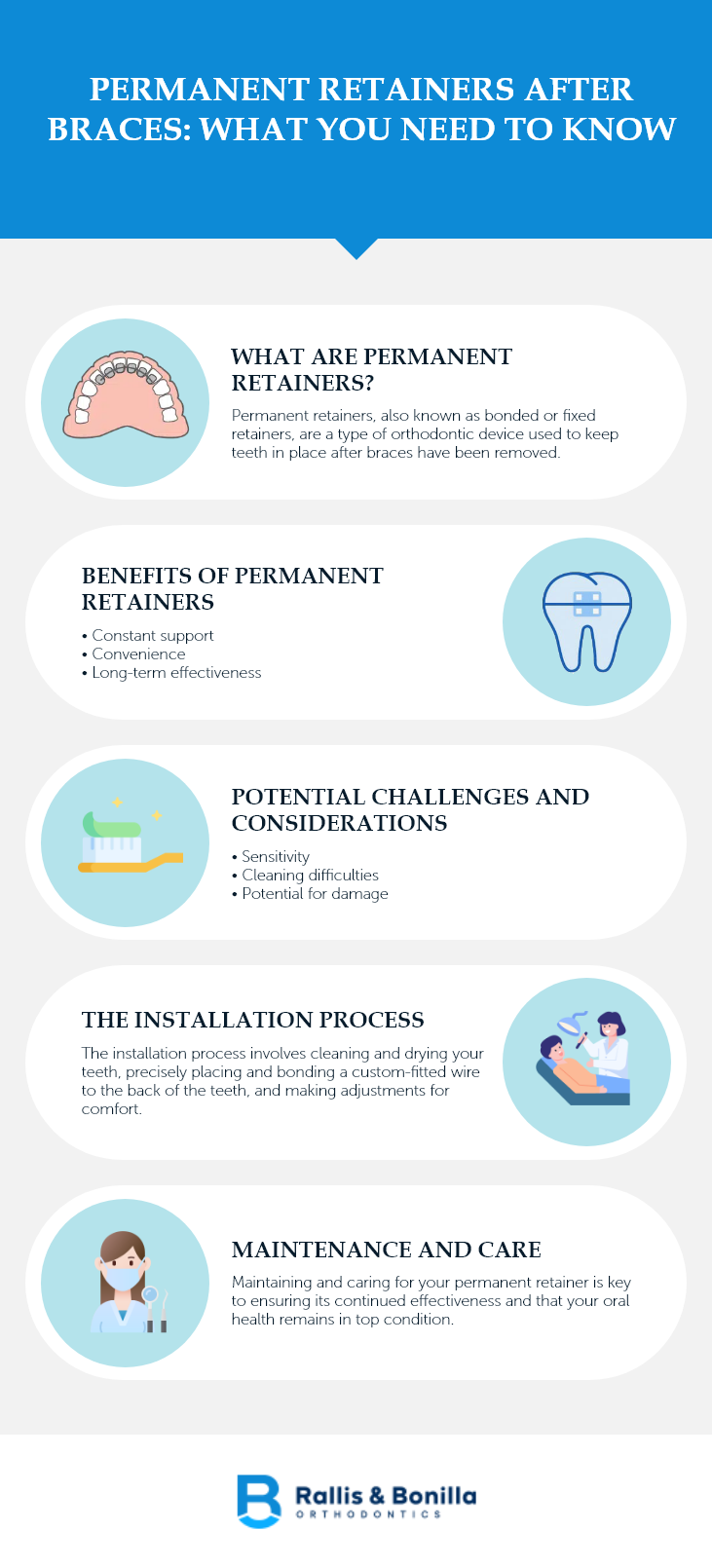After months or even years of wearing braces, it’s crucial to consider how to maintain that new, perfect alignment of your teeth. Permanent retainers are a popular option for ensuring your smile stays straight and beautiful over time. This blog post will explore what permanent retainers are, their benefits, how they compare to removable retainers, and what you need to know about their care and maintenance. Whether you’re just about to get your braces off or considering long-term options for your dental alignment, understanding permanent retainers will help you make informed decisions for a lasting smile.
What Are Permanent Retainers?
Permanent retainers, also known as bonded or fixed retainers, are a type of orthodontic device used to keep teeth in place after braces have been removed. Unlike removable retainers that you can take out of your mouth, permanent retainers are bonded directly to the back of the teeth. Typically, they consist of a thin wire that is custom-fitted to the exact contour of your newly aligned teeth, usually attached to the front lower or upper teeth, where movement is most likely to occur after braces.
The main appeal of a permanent retainer is that it’s always working to maintain the alignment of your teeth without requiring any action from you. Once installed, it’s completely out of sight and does not affect your speech or the way you eat. This type of retainer is particularly beneficial for those who might not remember to wear a removable retainer as consistently as needed. With a permanent retainer, your teeth can stay straight indefinitely, helping you maintain your confident new smile without additional hassle.
Benefits of Permanent Retainers
Permanent retainers offer several benefits that make them a popular choice for maintaining the alignment of your teeth after braces:
- Constant Support – One of the main advantages of permanent retainers is their constant presence. Because they are fixed, they continuously work to maintain tooth alignment without the need for you to remember to put them in or take them out.
- Invisibility – Permanent retainers are bonded to the back of your teeth, making them completely invisible when you smile or talk. This discreet placement allows you to enjoy a natural-looking smile without visible dental appliances.
- Convenience – You won’t have the hassle of removing it before eating or brushing, nor the worry about losing it. This makes them particularly convenient for everyday life, especially for younger patients or those with busy lifestyles.
- Long-Term Effectiveness – Because they are always in place, permanent retainers can be more effective at preventing teeth from gradually shifting back to their original positions compared to removable retainers that may not be worn as consistently.
Permanent retainer offers a practical and effective solution for anyone looking to maintain their orthodontic results with minimal effort.
Potential Challenges and Considerations
While permanent retainers are highly effective in maintaining your beautiful smile after braces, there are a few potential challenges and considerations to keep in mind:
- Cleaning Difficulties – Because permanent retainers are fixed to the teeth, they can make flossing more challenging. It’s important to use floss threaders or water flossers to navigate around the wire and keep the area clean, ensuring that no food particles or plaque build-up.
- Potential for Damage – The wire of a permanent retainer is durable but can be damaged if you bite down on hard foods. To prevent damage, it’s advisable to avoid chewing on ice, hard candies, or other hard objects.
- Long-Term Commitment – Once a permanent retainer is placed, it typically stays in for many years, possibly indefinitely. You’ll need to be comfortable with a long-term commitment to having something attached to your teeth.
- Regular Check-Ups – To ensure that the retainer remains effective and does not cause any oral health issues, regular visits to the orthodontist are essential. These check-ups will help address any issues with the retainer and ensure your teeth stay healthy.
- Sensitivity – Some people may initially experience slight discomfort or a sensation of tightness when the permanent retainer is first installed. Typically, this feeling dissipates quickly as you become accustomed to its presence.
Being aware of these considerations can help you manage your permanent retainer more effectively and maintain both its condition and your oral health. Despite these challenges, many find the benefits of a worry-free, effective solution for maintaining their new smile well worth it.
The Installation Process
The installation process for a permanent retainer is straightforward and typically involves a quick, painless procedure at our office. Here’s what you can expect:
- Preparation – First, we will thoroughly clean and dry your teeth. This ensures that the bonding surface is optimal for placing the retainer.
- Placement – The retainer, which is a custom-fitted thin wire, is carefully placed along the inner surfaces of your teeth. It’s usually attached to the lower front teeth, which are the most likely to shift post-braces.
- Bonding Process – Once correctly positioned, the wire is bonded to the teeth using a dental adhesive. A special light might be used to harden the bonding material quickly and secure the wire in place.
- Final Adjustments – We will make any necessary adjustments to ensure the retainer is comfortable and does not affect your bite or speech.
- Instructions – Before you leave, we will show you how to care for your new retainer and schedule follow-up appointments to monitor your progress.
The entire process generally takes only one short visit and involves minimal discomfort. It’s a simple step that plays a crucial role in maintaining the alignment of your teeth after the removal of braces, ensuring that your straight teeth are preserved.
Maintenance and Care
Maintaining and caring for your permanent retainer is key to ensuring it continues to function effectively and that your oral health remains in top condition. Here are some straightforward and easy-to-follow tips:
- Maintain Good Oral Hygiene – Brush your teeth twice a day as usual, and put extra effort into areas around your retainer. Using a soft-bristled toothbrush, gently clean the wire and the back of your teeth to remove plaque and food particles.
- Flossing – Flossing can be more challenging with a permanent retainer, but it’s crucial for preventing gum disease and tooth decay. Use a floss threader or a water flosser to navigate around the wire and clean between the teeth and under the retainer thoroughly.
- Avoid Hard Foods – To prevent damaging your retainer, avoid biting directly into hard foods like apples or carrots. Instead, cut them into smaller pieces. Also, steer clear of chewing on hard objects like pens, ice, or hard candy.
- Regular Check-Ups – Schedule regular visits with us to ensure your retainer is intact and functioning as intended. These check-ups are also a good opportunity to address any concerns or discomfort you may be experiencing.
- Report Any Issues Promptly – If you notice any signs of damage or discomfort with your retainers, like looseness, breakage, or irritation, contact us immediately.
- Wear a Mouthguard During Sports – When engaging in contact sports or martial arts, wear a mouthguard to protect your teeth from impact.
By adhering to these care guidelines, you can help extend the life of your permanent retainer and enjoy a healthy smile. Remember, a little care goes a long way in preserving the benefits of your orthodontic treatment.
Comparing Permanent and Removable Retainers
Choosing between permanent and removable retainers is an important decision that depends on your lifestyle, comfort, and orthodontic needs. Here’s a comparison of the two to help you make an informed choice:
Visibility:
- Permanent retainers are bonded to the back of the teeth, making them virtually invisible when you smile or talk.
- Removable retainers are made of clear, transparent plastic or metal wires that fit over the teeth. They need to be replaced every few years as they wear down.
Maintenance:
- Permanent retainers require diligent oral hygiene as they can make flossing challenging.
- Removable retainers make dental hygiene much easier to maintain, as you can remove them to brush and floss your teeth.
Convenience:
- Permanent retainers offer the convenience of not having to remember to wear them since they are always in place.
- Removable retainers provide the flexibility to be taken out for eating, brushing, or special occasions, but they require discipline to maintain teeth alignment.
Durability and Risk:
- Permanent retainers are very durable and eliminate the risk of being lost or forgotten. However, they can be damaged by hard foods or if not cared for properly.
- Removable retainers can be lost or damaged more easily since they are taken out frequently. They also require careful handling and safe storage when not in use.
Both types of retainers have their advantages and considerations. Discussing your daily habits, commitment to oral care, and personal preferences with your orthodontist will ensure you choose the one that best fits your needs and helps maintain your beautiful new smile.
As you consider the best options for maintaining your smile after braces, Rallis and Bonilla Orthodontics is here to guide you every step of the way. With convenient locations at North Star, 84th Street, and Yankee Hill, our expert team is dedicated to providing personalized care that meets your specific needs. Whether you’re leaning towards a permanent retainer for its simplicity or prefer the flexibility of a removable one, we’re committed to helping you make the best choice for your long-term dental health. Visit us at any of our locations to discuss how we can help you maintain that perfect smile with the right orthodontic retainers.

